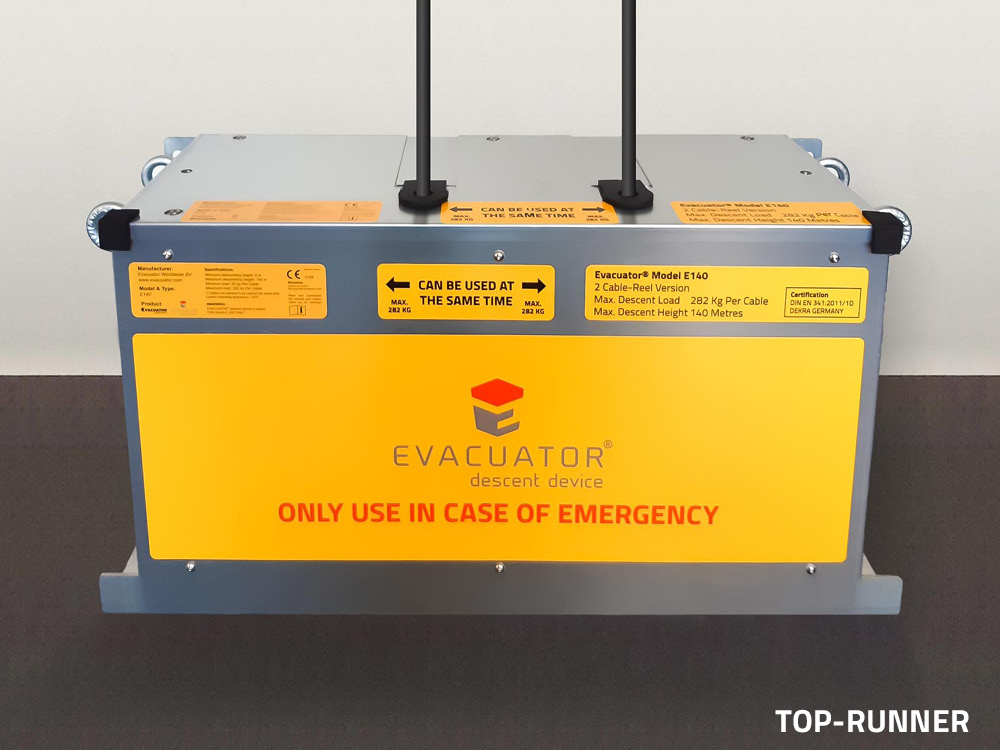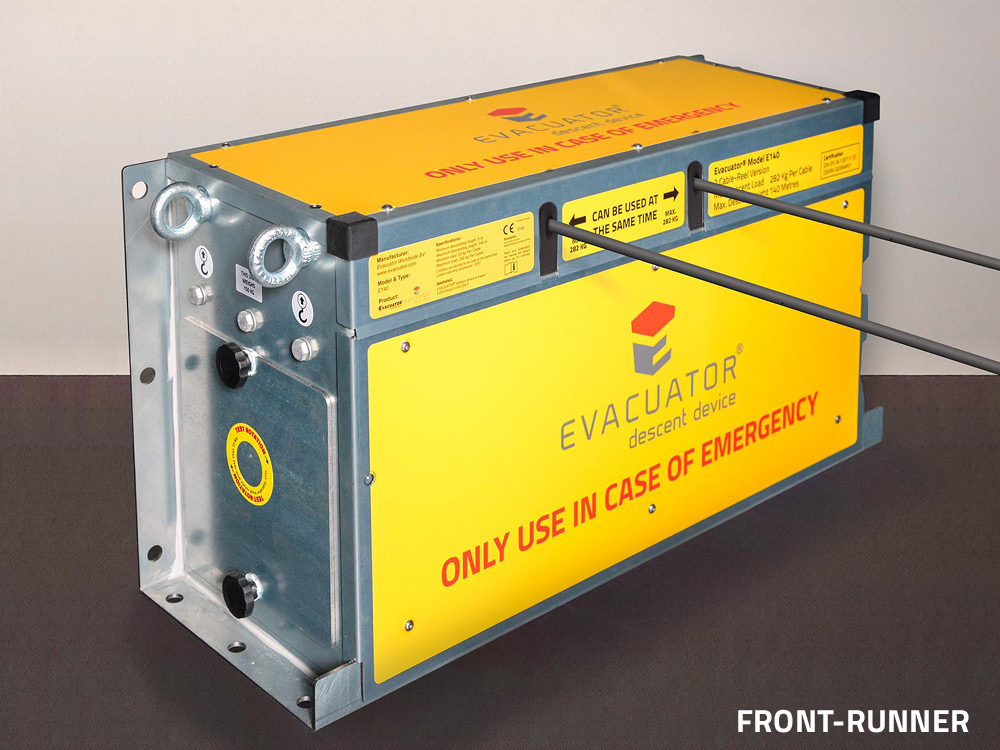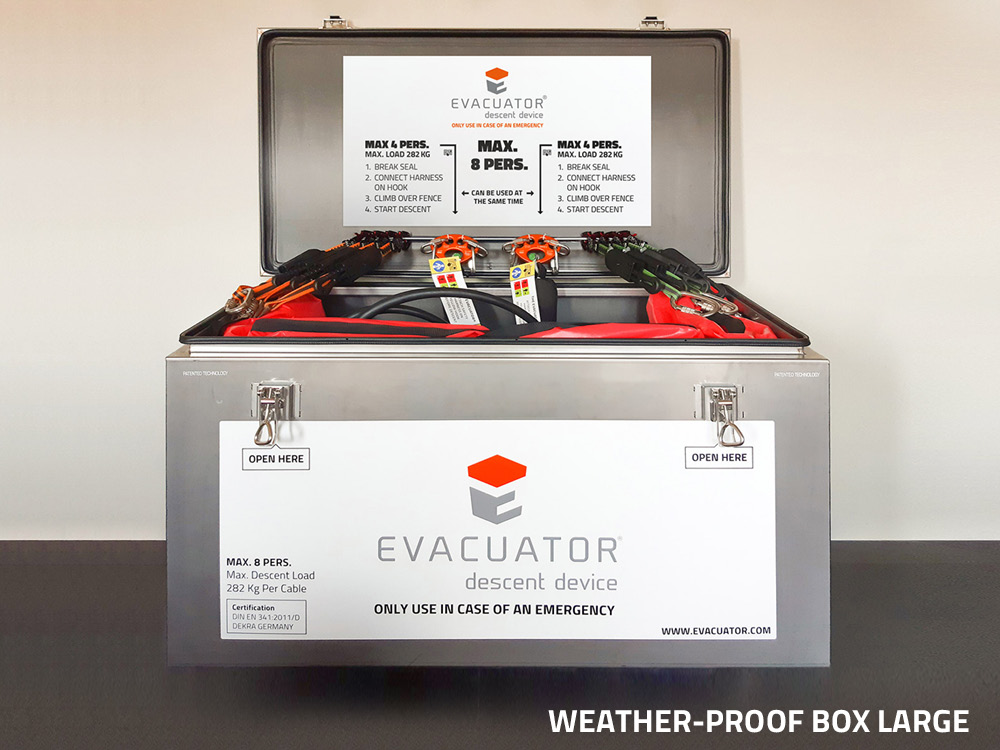WE ARE PROUD
THE EVACUATOR® ESCAPE DESCENT SYSTEM SIGNIFICANTLY IMPROVES THE SAFETY AND SURVIVABILITY OF TECHNICIANS IN THE WIND INDUSTRY
Internal installation WINDTURBINES
Escape routes, installation & operation
The Evacuator® escape descent system will be permanently installed on a central location somewhere inside the nacelle and its steel cables will already be permanently fixed at the emergency exits, providing two separates and independent escape routes.
Additional safety harnesses can be stored at the emergency exits.





WIND TURBINE Brand Independent
EXTERNAL INSTALLATION WINDTURBINES
The Evacuator® escape descent system can also be permanently installed outside on top of the turbine in a weatherproof storage box which is typhoon proof!
At least 4 survival suits including safety harnesses can be stored alongside the Evacuator® in the large storage box.




WIND TURBINE Brand Independent
THE EVACUATOR® ESCAPE DESCENT SYSTEM SIGNIFICANTLY IMPROVES THE SAFETY AND SURVIVABILITY OF PEOPLE IN PANIC SITUATIONS AT HEIGHTS
- A Fire Proof system up to 1200 degrees Celsius fitted with steel cables.
- Panic Proof, instinctively simple to use, connect harnesses on preinstalled escape-hooks and start descent.
- Escape-procedure within 10 seconds, just click on and go.
- A fully automatic controlled descent, ±1 m/s.
- The steel cables cannot burn or melt and can't get entangled.
- Safe descent at all wind speeds.
- Safe descent when structure is on fire and safe to use in extreme wet conditions or heavy rain fall.
- No time consuming preparations due to pre-installed and fixed installation at the emergency escape hatches, always there where you need it, immediately ready to use.
- No electricity required.
- Multiple persons can descent, the total Max. descent load on the system is 564 Kg at the same time (Max. descent load per cable-reel 282 Kg).
- In case of acute health problems/cardiac arrest a person can be safely on the ground within the 6 Golden minutes.
- Escape procedure can be done with 1 hand (in case injury has been sustained to other hand).
- Long Lifespan >30 years.
- Low costs of ownership.
- Easy installation on all high structures, wind turbine independent, onshore and offshore.
- In case of wind turbines: Installation does not damage the nacelle-construction and does not interfere annual maintenance in the nacelle (No drilling required).
- Certification by DEKRA Germany EN341, Class D, in compliance with ANSI Z359/CSA Z259.
- Does not require any special training but training models are available for educational purposes and multiple descent experiences.
- Maintenance friendly, visual inspection and system-test approx. 15 minutes.
- Leasing options possible.
BRINGS COMPLIANCE:
The Evacuator escape descent system brings compliance to the Official European Safety Standard for Wind Turbines EN50308, Paragraph 4.2.2: “The descent device has to be fireproof enough to allow escape from the nacelle to the ground in the event of fire, it shall be suitable for the numbers of persons to be evacuated”.
BRINGS COMPLIANCE:
The Evacuator escape descent system brings adherence to the UK Offshore Safety Directive Regulator/HSE-Offshore Emergency Response Inspection Guide,
Appendix 8: MEANS OF ESCAPE,
PFEER ACoP paragraph 219 and 220: Dutyholders should have selected means of escape based on their contribution to reducing the risks of those who may have to escape from the installation to as low as reasonably practicable (ALARP).



